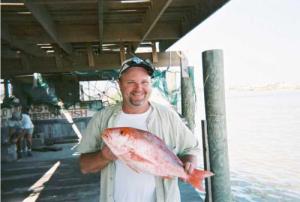Post
Texas Fishing Piers Yield Rewards
Crevalle Jack, Pacific Crevalle Jack, Red Drum, Regional Fishing, Saltwater Fish Species, Saltwater Fishing, Tackle Tips & How To's, Texas Fishing Articles, United States Fishing Articles | Texas theangler PM

Texas fishing piers provide a safe, comfortable connection to the sea and the big-league sportfish that inhabit it. On the right time and tide, Texas pier fishermen post some exceptional catches.
Wind and weather play nasty tricks on bay fishermen through spring and summer, but conditions beneath beachfront piers this time of year always are favorable for one species or another.
When the surf is roiled and sandy, sharks and bull reds to 50 pounds or more patrol the guts and bars off the ends of piers. As wind settles and water begins to clear, 20-pound jack crevalle prowl the color change looking for easy meals. Reds stick around to get what they can, and the occasional cobia to 60 pounds might slip inshore to slurp up a big bait as well.
On those rare days when light onshore wind and strong tides wash green current right onto dry sand, all the players get into the game. That lineup includes surprising numbers of bullet-fast king mackerel to 40 pounds and the odd triple-digit tarpon, which is most apt to wander within casting range on a late afternoon or overnight rising tide.
The last board at the end of a Texas pier, which too many people perceive to be the best and only fishing spot beyond the parking lot, attracts two types of anglers.
There are the tourists, of course, drawn by the fantasy of what oceanic beast might intercept casts aimed at the horizon over water that reaches beyond it. Mostly, they fish undersized baits on tackle ill suited to the task; hope springs eternal, we can suppose.
Then there are the locals, weathered men and women who know every notch in the railing and understand exactly which conditions add up to the best and biggest fish. They tote custom rods, well-oiled reels and buckets filled with fresh baits they caught themselves.
There is room on the T-head for everyone most days and nights; weekends and holidays can get crowded, however, and sometimes unpleasant. On rare occasion you may witness a few loud, rude exchanges between locals and tourists on fishing piers, mostly between people who could have done everyone a favor by staying home that day.
Trouble usually starts when an inexperienced fisherman launches an errant cast over half a dozen lines streaming far into the Gulf. Retrieving that bad cast causes tangles, which must be untangled, after which everyone caught up in the mess must rebait, recast and reset.
Most veteran pier fishermen accept the odd snarl as unavoidable, something more to laugh about than get riled over. Occasionally, however, tempers wear thin.
On the average day or night, the big-fish chasers pass more time talking than actually doing anything. Once the baits are prepared, lines are cast and rods are set, there is nothing to do
but wait. Eventually, not on any set schedule, you might replace old bait with a fresh one. The fish probably don’t care either way, but it’s something to do.
When a reel’s warning clicker signals a strike, ears and eyes focus on the stack of rods leaned against the railing. If fortune smiles, it is your rod that dances with life. You grab the rig, crank up the slack, lean back hard and watch the rod roll against the powerful pull of a huge fish.
Seeing bent rods keeps thing interesting while providing on-site training. You can learn a lot by watching or talking to the anglers who “have it wired.”
The list of species moving within reach of piers is impressive. The seasonal possibilities include black drum, gafftop catfish, red drum, speckled trout, sand trout, flounder, croaker, whiting, sheepshead, ladyfish, bluefish, jack crevalle, Spanish mackerel, tarpon, sharks, and pompano. On super-green tides, offshore migrants such as king mackerel and ling occasionally swing within reach of surf T-Heads.
More reliable but admittedly less desirable species are sea catfish (hardheads), pinfish (piggy perch), and stingrays.
The point is that a coastal pier can sit over a variety of fish and much of this bounty is within reach of a youngster or beginner. The numerous smaller species can be caught on basic spincast, spinning or casting tackle; in fact, a piece of cut bait or “fresh dead” shrimp soaked on or just off bottom is a magnet for a peck-peck-peck parade of panfish.
With or without live bait, it is a rare day when the light-tackle angler willing to compromise cannot catch something from a coastal pier. This is a fine way to corral a group of kids and get them outdoors on a sunny Saturday. A full day on a pier is cheaper than three hours at a video arcade, and the end results can be a lot more rewarding.
